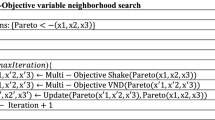Abstract
Hiking is among the most popular outdoor activities. In this paper, we introduce the hiking tourist problem (HTP) to support hikers in their trip planning to attractive hiking spots in a certain region. In the HTP, a set of hikes out of a larger set of potential hikes is selected and the mode of transport between the hiking locations is determined. The considered constraints involve a minimum and a maximum number of travel days, a maximum total cumulative elevation gain of all selected hikes and a maximum number of hikes. Two objectives are optimized concurrently: the total attractiveness of the travel plan is maximized and its total emissions are minimized. Several families of valid inequalities are discussed and a bi-objective branch-and-bound algorithm is tailored to solve the proposed problem. In a computational study on realistic instances for different regions in France, the impact of the proposed valid inequalities is analyzed and the trade-off between attractiveness and emissions is discussed.










Similar content being viewed by others
References
Amini A, Tavakkoli-Moghaddam R, Ebrahimnejad S (2020) A bi-objective transportation-location arc routing problem. Transp Letters 12(9):623–637
Aneja YP, Nair KPK (1979) Bicriteria transportation problem. Manag Sci 25:73–78
Archetti C, Speranza MG, Corberán A, Sanchis JM, Plana I (2014) The team orienteering arc routing problem. Transp Sci 48(3):442–457
Archetti C, Corberán Ángel, Plana I, Sanchis JM, Speranza MG (2015) A matheuristic for the team orienteering arc routing problem. Eur J Oper Res 245(2):392–401
Archetti C, Corberán Ángel, Plana I, Sanchis JM, Speranza MG (2016) A branch-and-cut algorithm for the orienteering arc routing problem. Comput Operat Res 66:95–104
Behrens DA, Getzner M (2009) Sustainable management of an alpine national park: handling the two-edged effect of tourism. Central Eur J Operat Res 17(3):233–253
Boyacı B, Dang TH, Letchford AN (2021) Vehicle routing on road networks: How good is euclidean approximation? Comput Operat Res 129:105197
Buczkowska S, Coulombel N, de Lapparent M (2019) A comparison of euclidean distance, travel times, and network distances in location choice mixture models. Netw Spat Econ 19(4):1215–1248
Chao I-M, Golden BL, Wasil EA (1996) The team orienteering problem. Eur J Operat Res 88(3):464–474
Chen C, Gao L, Xie X, Wang Z (2020) Enjoy the most beautiful scene now: a memetic algorithm to solve two-fold time-dependent arc orienteering problem. Front Comput Sci 14(2):365–377
Dasdemir E, Batta R, Köksalan M, Tezcaner Öztürk D (2022) Uav routing for reconnaissance mission: A multi-objective orienteering problem with timedependent prizes and multiple connections. Comput Operat Res 145:105882
Dhein G, de Araújo OCB, Cardoso G Jr (2018) Genetic local search algorithm for a new bi-objective arc routing problem with profit collection and dispersion of vehicles. Expert Syst Appl 92:276–288
Dolan ED, Moré JJ (2002) Benchmarking optimization software with performance profiles. Math Program 91(2):201–213
Duarte-Duarte JB, Talero-Sarmiento LH, Rodríguez-Padilla DC (2021) Methodological proposal for the identification of tourist routes in a particular region through clustering techniques. Heliyon 7(4):e06655
Ehrgott M, Gandibleux X (2006) Bound sets for biobjective combinatorial optimization problems. Comput Operat Res 34:2674–2694
European Market Research (2022). Global hiking footwear market: By design style: Low cut, mid cut, high cut; by distribution channel: Offline retail stores, online retail stores; by end user: Men, women, kids; regional analysis; historical market and forecast (2018-2028); market dynamics: Swot analysis; competitive landscape; industry events and developments. , https://www.expertmarketresearch.com/reports/hiking-footwear-market (last accessed December 11, 2022), ,
Friedrich M (2016) Evaluating the service quality in multi-modal transport networks. Transp Res Proc 15:100–112
Fritz D, Heinfellner H, Lambert S (2021) Die Ökobilanz von personenkraftwagen (No. REPORT REP-0763). https://www.umweltbundesamt.at/fileadmin/site/publikationen/rep0763.pdf
Gonçalves DNS, de Morais Gonçalves C, de Assis TF, da Silva MA (2014) Analysis of the difference between the euclidean distance and the actual road distance in brazil. Transp Res Proc 3:876–885
Heinold A, Meisel F (2018) Emission rates of intermodal rail/road and road-only transportation in europe: A comprehensive simulation study. Transp Res Part D Transp Environ 65:421–437
Jepsen MK, Petersen B, Spoorendonk S, Pisinger D (2014) A branch-and-cut algorithm for the capacitated profitable tour problem. Discret Optim 14:78–96
Knopp S, Biesinger B, Prandtstetter M (2021) Mobility offer allocations in corporate settings. EURO J Comput Optim 9:100010
Lacomme P, Prins C, Sevaux M (2006) A genetic algorithm for a bi-objective capacitated arc routing problem. Comput Operat Res 33(12):3473–3493
Lee SA, Manthiou A, Chiang L, Tang LR (2018) An assessment of value dimensions in hiking tourism: Pathways toward quality of life. Int J Tour Res 20(2):236–246
Li J, Fu P (2012) A label correcting algorithm for dynamic tourist trip planning. J Softw 7(12):2899–2905
Matl P, Nolz PC, Ritzinger U, Ruthmair M, Tricoire F (2017) Bi-objective orienteering for personal activity scheduling. Comput Operat Res 82:69–82
Meza J, Montoya-Torres JR (2021) Tourist trip design with heterogeneous preferences, transport mode selection and environmental considerations. Ann Operat Res 305(1):227–249
Molokáč M, Hlaváčová J, Tometzová D, Liptáková E (2022). The preference analysis for hikers’ choice of hiking trail. Sustainability, 14(11)
Moszoro M, Soto M (2022) Road quality and mean speed score (Tech. Rep.). Washington: International Monetary Fund. (IMF Working Papers 2022/095)
Outdoor Foundation (2022). Number of hiking participants in the united states from 2010 to 2021 (in millions). Statista, www.statista.com/statistics/191240/participants-in-hiking-in-the-us-since-2006/ (last accessed December 7, 2022)
Păcurar CM, Albu R-G, Păcurar VD (2021) Tourist route optimization in the context of covid-19 pandemic. Sustainability 13(10)
Parragh SN, Tricoire F (2019) Branch-and-bound for bi-objective integer programming. Inf J Comput 31(4):805–822
Parragh SN, Tricoire F, Gutjahr WJ (2022) A branch-and-benders-cut algorithm for a bi-objective stochastic facility location problem. Spectrum 44(2):419–459
Reiter P, Gutjahr WJ (2012) Exact hybrid algorithms for solving a bi-objective vehicle routing problem. Central Eur J Operat Res 20:19–43
Riera-Ledesma J, Salazar-González JJ (2017) Solving the team orienteering arc routing problem with a column generation approach. Eur J Operat Res 262(1):14–27
Sánchez-Romero M, Prskawetz A (2020) Optimal time allocation in active retirement. Central Eur J Operat Res 2:401–424
Schilde M, Doerner K, Hartl R, Kiechle G (2009) Metaheuristics for the biobjective orienteering problem. Swarm Intell 3(3):179–201. https://doi.org/10.1007/s11721-009-0029-5
Souffriau W, Vansteenwegen P, Berghe GV, Oudheusden DV (2011) The planning of cycle trips in the province of east flanders. Omega 39(2):209–213
Souffriau W, Maervoet J, Vansteenwegen P, Vanden Berghe G, Van Oudheusden D (2009) A mobile tourist decision support system for small footprint devices. J. Cabestany, F. Sandoval, A. Prieto, & J. Corchado (Eds.), Bio-inspired systems: Computational and ambient intelligence (Vol. 5517, p. 1248-1255). Springer Berlin Heidelberg
Souffriau W, Vansteenwegen P (2010) Tourist trip planning functionalities: State-of-the-art and future. Daniel F, Facca F (Eds.), Current trends in web engineering (Vol. 6385, p. 474-485). Springer Berlin Heidelberg
Tricoire F, Parragh SN, Gansterer M (2016) The Golf Tourist Problem. H. Dawid, K.F. Doerner, G. Feichtinger, Kort, PM, Seidl A (Eds.), Dynamic perspectives on managerial decision making (p. 473-489). Springer
Tu Y, Tu Y, Liu L, Nie L (2022) Travel route planning of core scenic spots based on best-worst method and genetic algorithm: a case study. Manag Syst Eng 1:4
Vansteenwegen P, Souffriau W, Oudheusden DV (2011) The orienteering problem: A survey. Eur J Operat Res 209(1):1–10
Verbeeck C, Vansteenwegen P, Aghezzaf E-H (2014) An extension of the arc orienteering problem and its application to cycle trip planning. Transp Res Part E Logist Transp Rev 68:64–78
Author information
Authors and Affiliations
Corresponding author
Ethics declarations
Conflict of interests
The author declares no conflict of interests.
Research involving human participants and/or animals
Not applicable.
Informed consent
Not applicable.
Additional information
Publisher's Note
Springer Nature remains neutral with regard to jurisdictional claims in published maps and institutional affiliations.
Rights and permissions
Springer Nature or its licensor (e.g. a society or other partner) holds exclusive rights to this article under a publishing agreement with the author(s) or other rightsholder(s); author self-archiving of the accepted manuscript version of this article is solely governed by the terms of such publishing agreement and applicable law.
About this article
Cite this article
Tricoire, F., Parragh, S.N. & Gansterer, M. The hiking tourist problem. Cent Eur J Oper Res 32, 183–207 (2024). https://doi.org/10.1007/s10100-023-00895-9
Accepted:
Published:
Issue Date:
DOI: https://doi.org/10.1007/s10100-023-00895-9




